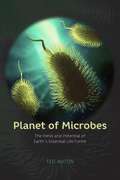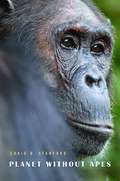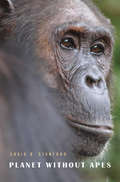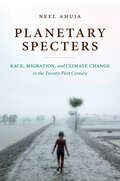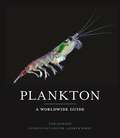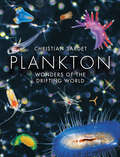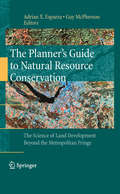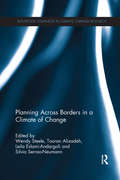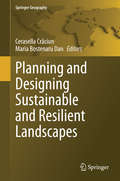- Table View
- List View
Planet of Microbes: The Perils and Potential of Earth's Essential Life Forms
by Ted AntonWe live in a time of unprecedented scientific knowledge about the origins of life on Earth. But if we want to grasp the big picture, we have to start small—very small. That’s because the real heroes of the story of life on Earth are microbes, the tiny living organisms we cannot see with the naked eye. Microbes were Earth’s first lifeforms, early anaerobic inhabitants that created the air we breathe. Today they live, invisible and seemingly invincible, in every corner of the planet, from Yellowstone’s scalding hot springs to Antarctic mountaintops to inside our very bodies—more than a hundred trillion of them. Don’t be alarmed though: many microbes are allies in achieving our—to say nothing of our planet’s—health. In Planet of Microbes, Ted Anton takes readers through the most recent discoveries about microbes, revealing their unexpected potential to reshape the future of the planet. For years, we knew little about these invisible invaders, considering them as little more than our enemies in our fight against infectious disease. But the more we learn about microbes, the more it’s become clear that our very lives depend on them. They may also hold the answers to some of science’s most pressing problems, including how to combat a warming planet, clean up the environment, and help the body fight off a wide variety of diseases. Anton has spent years interviewing and working with the determined scientists who hope to harness the work of microbes, and he breaks down the science while also sharing incredible behind-the-scenes stories of the research taking place everywhere from microbreweries to Mars. The world’s tiniest organisms were here more than three billion years before us. We live in their world, and Planet of Microbes at last gives these unsung heroes the recognition they deserve.
The Planet Remade: How Geoengineering Could Change the World
by Oliver MortonThe risks of global warming are pressing and potentially vast. The difficulty of doing without fossil fuels is daunting, possibly even insurmountable. So there is an urgent need to rethink our responses to the crisis. To meet that need, a small but increasingly influential group of scientists is exploring proposals for planned human intervention in the climate system: a stratospheric veil against the sun, the cultivation of photosynthetic plankton, fleets of unmanned ships seeding the clouds. These are the technologies of geoengineering—and as Oliver Morton argues in this visionary book, it would be as irresponsible to ignore them as it would be foolish to see them as a simple solution to the problem. The Planet Remade explores the history, politics, and cutting-edge science of geoengineering. Morton weighs both the promise and perils of these controversial strategies and puts them in the broadest possible context. The past century’s changes to the planet—to the clouds and the soils, to the winds and the seas, to the great cycles of nitrogen and carbon—have been far more profound than most of us realize. Appreciating those changes clarifies not just the scale of what needs to be done about global warming, but also our relationship to nature. Climate change is not just one of the twenty-first century’s defining political challenges. Morton untangles the implications of our failure to meet the challenge of climate change and reintroduces the hope that we might. He addresses the deep fear that comes with seeing humans as a force of nature, and asks what it might mean—and what it might require of us—to try and use that force for good.
The Planet Remade: How Geoengineering Could Change the World
by Oliver MortonThe risks of global warming are pressing and potentially vast. The difficulty of doing without fossil fuels is daunting, possibly even insurmountable. So there is an urgent need to rethink our responses to the crisis. To meet that need, a small but increasingly influential group of scientists is exploring proposals for planned human intervention in the climate system: a stratospheric veil against the sun, the cultivation of photosynthetic plankton, fleets of unmanned ships seeding the clouds. These are the technologies of geoengineering—and as Oliver Morton argues in this visionary book, it would be as irresponsible to ignore them as it would be foolish to see them as a simple solution to the problem. The Planet Remade explores the history, politics, and cutting-edge science of geoengineering. Morton weighs both the promise and perils of these controversial strategies and puts them in the broadest possible context. The past century’s changes to the planet—to the clouds and the soils, to the winds and the seas, to the great cycles of nitrogen and carbon—have been far more profound than most of us realize. Appreciating those changes clarifies not just the scale of what needs to be done about global warming, but also our relationship to nature. Climate change is not just one of the twenty-first century’s defining political challenges. Morton untangles the implications of our failure to meet the challenge of climate change and reintroduces the hope that we might. He addresses the deep fear that comes with seeing humans as a force of nature, and asks what it might mean—and what it might require of us—to try and use that force for good.
The Planet Remade: How Geoengineering Could Change the World (PDF)
by Oliver MortonDespite the on-going political horse-trading over emissions targets, each piece of new scientific research offers further evidence that no feasible reduction in the emissions can now effectively mitigate the carbon crisis. With limited time for action, an increasingly influential minority of climate scientists are exploring proposals for planned human intervention in the biosphere. A stratospheric veil against the sun; the cultivation of photosynthetic plankton; a fleet of unmanned ships seeding clouds: these are technologies from the radical fringes of climate study, and they are chilling, not least given the risk of hostile use. And yet, we're now at the point where we have no choice but to take them very seriously indeed. The Planet Remade explores the science, history and politics behind these strategies. It looks at who might want to see geo-engineering techniques used, and why - and why others would be dead set against any such attempts. Throughout history, people have made huge changes to the planet - to the clouds and the soils, to the winds and the seas, to the great cycles of nitrogen and carbon - that are far more profound than often realized, and which can help us to fundamentally rethink our responses to global warming. With sensitivity, insight and expert science, Oliver Morton unpicks the moral implications of our responses to climate change, our fear that people have become a force of nature, and the potential for good in having such power. The Planet Remade is about imagining a world where people take care instead of taking control.
Planet Without Apes
by Craig B. StanfordCan we live with the consequences of wiping our closest relatives off the face of the Earth, and all the biological knowledge about ourselves that would die along with them? Extinction of the great apes threatens to become a reality within a few human generations. Stanford tells us how we can redirect the course of an otherwise bleak future.
Planet Without Apes
by Craig B. StanfordCan we live with the consequences of wiping our closest relatives off the face of the Earth, and all the biological knowledge about ourselves that would die along with them? Extinction of the great apes threatens to become a reality within a few human generations. Stanford tells us how we can redirect the course of an otherwise bleak future.
Planetary Accounting: Quantifying How to Live Within Planetary Limits at Different Scales of Human Activity
by Peter Newman Kate MeyerThis book presents a novel way to enable people, regardless of their scale of influence, to take responsibility for global environmental problems including climate change. It introduces a new framework called Planetary Accounting, which allows the Planetary Boundaries, non-negotiable limits for the environment, to be translated into limits for human activity. It shows how such limits can be broken down into chunks that can be managed at different levels (from individual and community, to business and sector levels, to cities and regions), and at any level of government. The book begins by summarising the science of climate change and introducing the notion of the Anthropocene – the “human age”. It highlights the importance of returning to and remaining within the Planetary Boundaries but shows that we can’t realistically do so unless we have a new approach to environmental accounting.The book then outlines how Planetary Accounting furnishes this new approach by combining sustainability science, change theory, and environmental accounting to create a scalable framework for environmental management that encourages systemic and individual change. The details of the science of and our human contribution to ten critical human pressures are then presented, and the book concludes with a guide for those seeking to apply Planetary Accounting in practice. Planetary Accounting could form the scientific underpinning of behaviour change programs, guide the development of policy and regulations, and provide both the basis for environmental laws, and the foundation of future global environmental agreements. It has been 50 years since the first views from space showed a blue planet alone in our solar system. This book is an historic opportunity to provide humanity for the first time with sufficient information to begin implementing Planetary Accounting.
Planetary Economics: Energy, climate change and the three domains of sustainable development
by Michael GrubbHow well do our assumptions about the global challenges of energy, environment and economic development fit the facts? Energy prices have varied hugely between countries and over time, yet the share of national income spent on energy has remained surprisingly constant. The foundational theories of economic growth account for only about half the growth observed in practice. Despite escalating warnings for more than two decades about the planetary risks of rising greenhouse gas emissions, most governments have seemed powerless to change course. Planetary Economics shows the surprising links between these seemingly unconnected facts. It argues that tackling the energy and environmental problems of the 21st Century requires three different domains of decision-making to be recognised and connected. Each domain involves different theoretical foundations, draws on different areas of evidence, and implies different policies. The book shows that the transformation of energy systems involves all three domains - and each is equally important. From them flow three pillars of policy – three quite distinct kinds of actions that need to be taken, which rest on fundamentally different principles. Any pillar on its own will fail. Only by understanding all three, and fitting them together, do we have any hope of changing course. And if we do, the oft-assumed conflict between economy and the environment dissolves – with potential for benefits to both. Planetary Economics charts how.
Planetary Economics: Energy, climate change and the three domains of sustainable development
by Michael GrubbHow well do our assumptions about the global challenges of energy, environment and economic development fit the facts? Energy prices have varied hugely between countries and over time, yet the share of national income spent on energy has remained surprisingly constant. The foundational theories of economic growth account for only about half the growth observed in practice. Despite escalating warnings for more than two decades about the planetary risks of rising greenhouse gas emissions, most governments have seemed powerless to change course. Planetary Economics shows the surprising links between these seemingly unconnected facts. It argues that tackling the energy and environmental problems of the 21st Century requires three different domains of decision-making to be recognised and connected. Each domain involves different theoretical foundations, draws on different areas of evidence, and implies different policies. The book shows that the transformation of energy systems involves all three domains - and each is equally important. From them flow three pillars of policy – three quite distinct kinds of actions that need to be taken, which rest on fundamentally different principles. Any pillar on its own will fail. Only by understanding all three, and fitting them together, do we have any hope of changing course. And if we do, the oft-assumed conflict between economy and the environment dissolves – with potential for benefits to both. Planetary Economics charts how.
A Planetary Economy
by Fraser Murison SmithThis book asks, how would a stable, prosperous economy of the future look if one started with a blank sheet of paper? Given that the world’s economy is locked into a coevolution with nature, the urgency of this question is brought into stark relief by the 2020 coronavirus pandemic and ongoing climate change. While physical technologies to build such an economy mostly exist, the social technologies, in the form of institutions, governance and policies, do not. The development of these social technologies will necessitate a reconsideration of economic norms: in particular, what is the economy for, and what are we, as actors within it, striving for? This book integrates normative, institutional, political and economic requirements into a systematic framework to drive our present growth economy toward a future planetarian one. It outlines a suite of interrelated policies to increase the economy’s material efficiency, establish a basic living standard, and reform the money system, while along the way eliminating economic debt and balancing government budgets. The framework and policies together form a paradigm of market planetarianism: the idea that the power of markets may be used to steer the economy toward a desired long-term goal. The methodological aspects of this paradigm are covered in the companion volume, Economics of a Crowded Planet.
Planetary Health: Safeguarding The Environment And Human Health In The Anthropocene
by Andrew Haines Howard FrumkinWe live in unprecedented times - the Anthropocene - defined by far-reaching human impacts on the natural systems that underpin civilisation. Planetary Health explores the many environmental changes that threaten to undermine progress in human health, and explains how these changes affect health outcomes, from pandemics to infectious diseases to mental health, from chronic diseases to injuries. It shows how people can adapt to those changes that are now unavoidable, through actions that both improve health and safeguard the environment. But humanity must do more than just adapt: we need transformative changes across many sectors - energy, housing, transport, food, and health care. The book discusses specific policies, technologies, and interventions to achieve the change required, and explains how these can be implemented. It presents the evidence, builds hope in our common future, and aims to motivate action by everyone, from the general public to policymakers to health practitioners.
Planetary Justice: Stories and Studies of Action, Resistance and Solidarity
by Kuntala Lahiri-Dutt Jenia Mukherjee Yin Paradies Aditya Ghosh Kalyan Rudra Amrita Sen Anwesha Haldar Lakshminarayan Satpati Sharon Stein Marlies Kustatscher Anne Poelina Aleryk Fricker Natasha Abhayawickrama Alex Baird Robin A Bellingham Sanjana Dutt Souvik Lal Chakraborty Beth Christie Alicia Flynn Naomi Godden Lowell Hunter Callum McGregor Ruchira Talukdar Dani Villafaña Bill Webb Sandra Wooltorton Julian S. YatesAvailable open access digitally under CC-BY-NC-ND licence. Bringing together interdisciplinary climate change scholarship and grassroots activism, this book considers the possibilities of planetary justice across human difference, generations, species and the concept of life and non-life. Writing amidst bushfires, cyclones, global climate strikes and a global pandemic, contributors from the Earth Unbound Collective share stories from India, Australia, Canada and Scotland. Chapters draw on Indigenous, Black, Southern, ecosocialist and ecofeminist perspectives to call for more radical and interconnected ideas of justice and solidarity. This accessible book features diverse voices that speak with the planet in the face of climate change, biodiversity loss and extinction. It explores the politics and practices of working towards a future where the planet thrives.
Planetary Justice: Stories and Studies of Action, Resistance and Solidarity
by Kuntala Lahiri-Dutt Jenia Mukherjee Yin Paradies Aditya Ghosh Kalyan Rudra Amrita Sen Anwesha Haldar Lakshminarayan Satpati Sharon Stein Marlies Kustatscher Anne Poelina Aleryk Fricker Natasha Abhayawickrama Alex Baird Robin A Bellingham Sanjana Dutt Souvik Lal Chakraborty Beth Christie Alicia Flynn Naomi Godden Lowell Hunter Callum McGregor Ruchira Talukdar Dani Villafaña Bill Webb Sandra Wooltorton Julian S. YatesAvailable open access digitally under CC-BY-NC-ND licence. Bringing together interdisciplinary climate change scholarship and grassroots activism, this book considers the possibilities of planetary justice across human difference, generations, species and the concept of life and non-life. Writing amidst bushfires, cyclones, global climate strikes and a global pandemic, contributors from the Earth Unbound Collective share stories from India, Australia, Canada and Scotland. Chapters draw on Indigenous, Black, Southern, ecosocialist and ecofeminist perspectives to call for more radical and interconnected ideas of justice and solidarity. This accessible book features diverse voices that speak with the planet in the face of climate change, biodiversity loss and extinction. It explores the politics and practices of working towards a future where the planet thrives.
Planetary Specters: Race, Migration, and Climate Change in the Twenty-First Century
by Neel AhujaNeel Ahuja tracks the figure of the climate refugee in public media and policy over the past decade, arguing that journalists, security experts, politicians, and nongovernmental organizations have often oversimplified climate change and obfuscated the processes that drive mass migration. To understand the systemic reasons for displacement, Ahuja argues, it is necessary to reframe climate disaster as interlinked with the history of capitalism and the global politics of race, wherein racist presumptions about agrarian underdevelopment and Indigenous knowledge mask how financial, development, migration, and climate adaptation policies reproduce growing inequalities. Drawing on the work of Cedric Robinson and theories of racial capitalism, Ahuja considers how the oil industry transformed the economic and geopolitical processes that lead to displacement. From South Asia to the Persian Gulf, Europe, and North America, Ahuja studies how Asian trade, finance, and labor connections have changed the nature of race, borders, warfare, and capitalism since the 1970s. Ultimately, Ahuja argues that only by reckoning with how climate change emerges out of longer histories of race, colonialism, and capitalism can we begin to build a sustainable and just future for those most affected by environmental change.
Plankton: A Worldwide Guide
by Tom Jackson Jennifer ParkerA richly illustrated guide to the marvelously diverse plankton of the world and their fundamental role in planetary food websPlankton are the unsung heroes of planet Earth. Passive drifters through the world&’s seas, oceans, and freshwater environments, most are invisible or very small, but some are longer than a whale. They are the global ocean&’s foundation food, supporting almost all oceanic life, and they are also vitally important for land-based plants, animals, and other organisms. Plankton provides an incomparable look at these remarkable creatures, opening a window on the elegance and grace of microscopic marine life.This engaging book reveals the amazing diversity of plankton, how they belong to a wide range of living groups, and how their ecology, lifestyles, and adaptations have evolved to suit an enormous range of conditions. It looks at plankton life cycles, the different ways plankton feed and grow, and the vast range of strategies they use for reproduction. It tracks where, how, and why plankton drift through the water; shares perspectives on migrations and population explosions or &“blooms&” and why they happen; and discusses the life-sustaining role of plankton in numerous intertwined food webs throughout the world.Beautifully illustrated, Plankton sheds critical light on how global warming, pollution, diminishing resources, and overexploitation will adversely impact planktonic life, and how these effects will reverberate to every corner of our planet.
Plankton: Wonders of the Drifting World
by Christian SardetAsk anyone to picture a bird or a fish and a series of clear images will immediately come to mind. Ask the same person to picture plankton and most would have a hard time conjuring anything beyond a vague squiggle or a greyish fleck. This book will change that forever. Viewing these creatures up close for the first time can be a thrilling experience—an elaborate but hidden world truly opens up before your eyes. Through hundreds of close-up photographs, Plankton transports readers into the currents, where jeweled chains hang next to phosphorescent chandeliers, spidery claws jut out from sinuous bodies, and gelatinous barrels protect microscopic hearts. The creatures’ vibrant colors pop against the black pages, allowing readers to examine every eye and follow every tentacle. Jellyfish, tadpoles, and bacteria all find a place in the book, representing the broad scope of organisms dependent on drifting currents. Christian Sardet’s enlightening text explains the biological underpinnings of each species while connecting them to the larger living world. He begins with plankton’s origins and history, then dives into each group, covering ctenophores and cnidarians, crustaceans and mollusks, and worms and tadpoles. He also demonstrates the indisputable impact of plankton in our lives. Plankton drift through our world mostly unseen, yet they are diverse organisms that form ninety-five percent of ocean life. Biologically, they are the foundation of the aquatic food web and consume as much carbon dioxide as land-based plants. Culturally, they have driven new industries and captured artists’ imaginations. While scientists and entrepreneurs are just starting to tap the potential of this undersea forest, for most people these pages will represent uncharted waters. Plankton is a spectacular journey that will leave readers seeing the ocean in ways they never imagined.
Plankton: Wonders of the Drifting World
by Christian SardetAsk anyone to picture a bird or a fish and a series of clear images will immediately come to mind. Ask the same person to picture plankton and most would have a hard time conjuring anything beyond a vague squiggle or a greyish fleck. This book will change that forever. Viewing these creatures up close for the first time can be a thrilling experience—an elaborate but hidden world truly opens up before your eyes. Through hundreds of close-up photographs, Plankton transports readers into the currents, where jeweled chains hang next to phosphorescent chandeliers, spidery claws jut out from sinuous bodies, and gelatinous barrels protect microscopic hearts. The creatures’ vibrant colors pop against the black pages, allowing readers to examine every eye and follow every tentacle. Jellyfish, tadpoles, and bacteria all find a place in the book, representing the broad scope of organisms dependent on drifting currents. Christian Sardet’s enlightening text explains the biological underpinnings of each species while connecting them to the larger living world. He begins with plankton’s origins and history, then dives into each group, covering ctenophores and cnidarians, crustaceans and mollusks, and worms and tadpoles. He also demonstrates the indisputable impact of plankton in our lives. Plankton drift through our world mostly unseen, yet they are diverse organisms that form ninety-five percent of ocean life. Biologically, they are the foundation of the aquatic food web and consume as much carbon dioxide as land-based plants. Culturally, they have driven new industries and captured artists’ imaginations. While scientists and entrepreneurs are just starting to tap the potential of this undersea forest, for most people these pages will represent uncharted waters. Plankton is a spectacular journey that will leave readers seeing the ocean in ways they never imagined.
Planned Management of Forests (Routledge Library Editions: Forestry)
by N. V. BrasnettOriginally published in 1953, this book was compiled to provide students of forestry with a simple outline of what the management of forests involves, and of the way in which forestry operations are organized and controlled. Topics discussed and explained include economic considerations, stock mapping, topography, climate, soils, form and distribution of crops, scientific forestry, destruction of forests, regulation by volume, area and size and forest protection.
Planned Management of Forests (Routledge Library Editions: Forestry)
by N. V. BrasnettOriginally published in 1953, this book was compiled to provide students of forestry with a simple outline of what the management of forests involves, and of the way in which forestry operations are organized and controlled. Topics discussed and explained include economic considerations, stock mapping, topography, climate, soils, form and distribution of crops, scientific forestry, destruction of forests, regulation by volume, area and size and forest protection.
The Planner’s Guide to Natural Resource Conservation: The Science of Land Development Beyond the Metropolitan Fringe
by Adrian X. Esparza Guy McPhersonMuch of the country’s recent population growth is situated in exurban areas. By many accounts exurbanization has become the dominant pattern of land development in the country and there is no indication it will slow in the foreseeable future (Theobald 2005; Brown et al. 2005; Glennon and Kretser 2005). By definition, exurban development takes place beyond the metropolitan fringe, often in rural and remote areas. The development of new exurban communities is a growing trend, especially in the West. In this case, developers and homebuilders seek large tracts of land, up to thousands of acres, in rural areas (typically within 50 miles of a large city) where they plan entire communities consisting of commercial, retail and residential land uses. Recreational amenities such as golf courses and hiking/biking trails are often included in these master-planned developments. Our philosophy is reflected in the book’s two objectives. First, we seek to document the extent and impacts of exurban development across the country. At issue is demonstrating why planners and the public-at-large should be concerned about exurbanization. We will demonstrate that even though exurbanization favors amenity rich regions, it affects all areas of the country through the loss of agricultural and grazing lands, impacts to watersheds and land modification. A summary of environmental impacts is presented, including the loss of wildlands and agricultural productivity, land modification, soil erosion, impacts to terrestrial hydrologic systems, the loss of biodiversity, nonnative and endangered species and other topics. Our second aim is to provide readers from diverse (nonscientific) backgrounds with a working knowledge of how and why exurbanization impacts environmental systems. This is accomplished by working closely to ensure contributors follow a specific outline for each chapter. First, contributors will spell out fundamental concepts, principles and processes that apply to their area of expertise (e.g., riparian areas). Contributors will move beyond a cursory understanding of ecological processes without overwhelming readers with the dense material found typically in specialized texts. For this reason, visuals and other support materials will be integral to each chapter. We have chosen contributors carefully based on their record as research scientists and acumen as educators. Second, once the mechanics have been laid out, authors will explain how and why land development in nearby areas influences ecosystems. Issues of interdependency, modification and adaptation, spatial scale and varying time horizons will be featured. Third, contributors will weigh in on the pros and cons of various land-development schemes. Fourth, authors will share their thinking on the merits of conservation devices such as wildlife corridors, open-space requirements and watershed management districts. Finally, each chapter will conclude by identifying pitfalls to avoid and highlighting "best practices" that will mitigate environmental problems or avoid them altogether. In sum, after completing each chapter, readers should have a firm grasp of relevant concepts and processes, an understanding of current research and know how to apply science to land-use decisions.
Planning Across Borders in a Climate of Change (Routledge Advances in Climate Change Research)
by Wendy Steele Tooran Alizadeh Leila Eslami-Andargoli Silvia Serrao-NeumannThe fixity or mobility of borders are key themes within the border studies literature and have useful critical application to urban and environmental planning through theory, pedagogy and practice. This offers potential for transformative change through the processes of re-bordering and re-orienting established boundary demarcations in ways that support and promote sustainability in a climate of change. Planning Across Borders in a Climate of Change draws on a range of diverse case studies from Australasia, North and South America, Europe, Africa, the Middle East and Asia and offers the application of border theory, concepts and principles to planning as a critical lens. It applies this lens to a range of international case studies in key areas such as climate change adaptation, food security, spatial planning, critical infrastructure and urban ecology. This collection fills an important gap in the border studies literature, bringing climate change considerations to bear on planning. It should be of interest to students, scholars and professionals in the field of urban and environmental planning, climate change adaptation, border studies, urban studies, human and political geography, environmental studies and development.
Planning Across Borders in a Climate of Change (Routledge Advances in Climate Change Research)
by Wendy Steele, Tooran Alizadeh, Leila Eslami-Andargoli and Silvia Serrao-NeumannThe fixity or mobility of borders are key themes within the border studies literature and have useful critical application to urban and environmental planning through theory, pedagogy and practice. This offers potential for transformative change through the processes of re-bordering and re-orienting established boundary demarcations in ways that support and promote sustainability in a climate of change. Planning Across Borders in a Climate of Change draws on a range of diverse case studies from Australasia, North and South America, Europe, Africa, the Middle East and Asia and offers the application of border theory, concepts and principles to planning as a critical lens. It applies this lens to a range of international case studies in key areas such as climate change adaptation, food security, spatial planning, critical infrastructure and urban ecology. This collection fills an important gap in the border studies literature, bringing climate change considerations to bear on planning. It should be of interest to students, scholars and professionals in the field of urban and environmental planning, climate change adaptation, border studies, urban studies, human and political geography, environmental studies and development.
Planning and Designing Sustainable and Resilient Landscapes (Springer Geography)
by Cerasella Crăciun Maria Bostenaru DanThis book deals with planning issues in landscape architecture, which start at the evaluation of the existing fabric of society, its history and memory, approached and conserved through photography, film and scenographic installations, a way in which the archetypes can be investigated, be it industrial derelict sites or already green spaces and cultural landscapes. It provides approaches to intervention, through rehabilitation and upgrade, eventually in participative manner. To such evaluation and promotion a couple of disciplines can contribute such as history of art, geography and communication science and of course (landscape) architecture. The field of landscape architecture reunites points of view from such different disciplines with a view to an active approach a contemporary intervention or conservation. The book presents case studies from several European countries (Romania, Germany, Austria, Italy, Portugal) mostly for large landscape in the outskirts of the cities and in the parks.
Planning and Environmental Protection: A Review of Law and Policy
by Chris E MillerThis collection of essays examines the roles which land use planning can play in the protection of the environment. The subjects covered range from traditional concerns like pollution,nuisance and contaminated land to biodiversity and the pursuit of sustainable development, which forms the defining element of current environmental policy across the European Community and in most other developed economies. Environmental assessment is discussed, along with the succession of public law actions (Twyford Down included) by environmental activists which were necessary to convince the English courts of the full implications (and the 'direct effect') of the EC Directive 85/337. The later chapters become progressively more concerned with the planning system as the forum of negotiation and more participatory approaches (as distinct from fiscal instruments and command and control regulation) to encouraging sustainability. The contributors represent a variety of academic disciplines (law, geography, planning, environmental management) offering complementary insights into the planner's role in allocating land uses so as to minimise waste generation and energy consumption as well as maximising local amenity.
Planning and Installing Solar Thermal Systems: A Guide for Installers, Architects and Engineers (Planning and Installing)
by German Solar Energy Society (DGS)Solar thermal systems available today offer efficiency and reliability. They can be applied in different conditions to meet space- and water-heating requirements in the residential, commercial and industrial building sectors. The potential for this technology and the associated environmental benefits are significant. This fully updated edition of 2004's bestselling guide offers clear guidance on planning and installing a solar thermal system, crucial to the successful uptake of this technology. All major topics for successful project implementation are included. Beginning with resource assessment and an outline of core components, it details solar thermal system design, installation, operation and maintenance for single households, large systems, swimming pool heaters, solar air and solar cooling applications. Details on how to market solar thermal technologies, a review of relevant simulation tools and data on selected regional, national and international renewable energy programmes are also provided. In short, the book offers comprehensive guidance for professionals who wish to install solar thermal technology and is a highly valued resource for architects and engineers alike who are working on new projects, electricians, roofers and other installers, craftsmen undertaking vocational training and anyone with a specialized and practical interest in this field. Published with DGS
